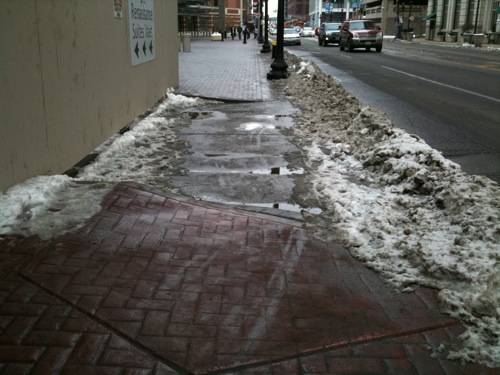Another Reason Corner Curb Ramps Don’t Work Well
|
|
Pedestrians generally walk in a straight line, stepping over curbs as necessary to keep going in the same direction.
People pushing strollers, or using wheelchairs, have to go not in a straight line, but where the curb ramp is placed. Ideally ramps would be located where we could also continue in a straight line.
But most St. Louis intersections place curb ramps, not in the natural line of travel, but at the apex of the corner. On a standard intersection of two streets at a 90° angle the corner ramp does save money by requiring fewer ramps – four rather than eight. The problem however, is the corner ramp has become the local default, even when it makes no sense to do so.

The example above is one where placing the curb ramps at the corners makes no sense at all. There is no opportunity to cross Washington Ave from either curb, the only direction to travel is straight ahead. Most of the year it is just annoying that I’m forced nearly into the nearby vehicle lane. When there is snow in the way I’m forced to go off the edge of the ramp and through some of the snow.
At other intersections I neatly got stuck because my line of travel was beyond the worn path of able bodied pedestrians. The corner ramp is marginally acceptable when you have two crosswalks meeting at a single point. The above ramps should have been constructed to permit a straight line of travel. The cost would have been the same, maybe even less because a ramp is less complex in a straight curb as opposed to on a corner.
– Steve Patterson




